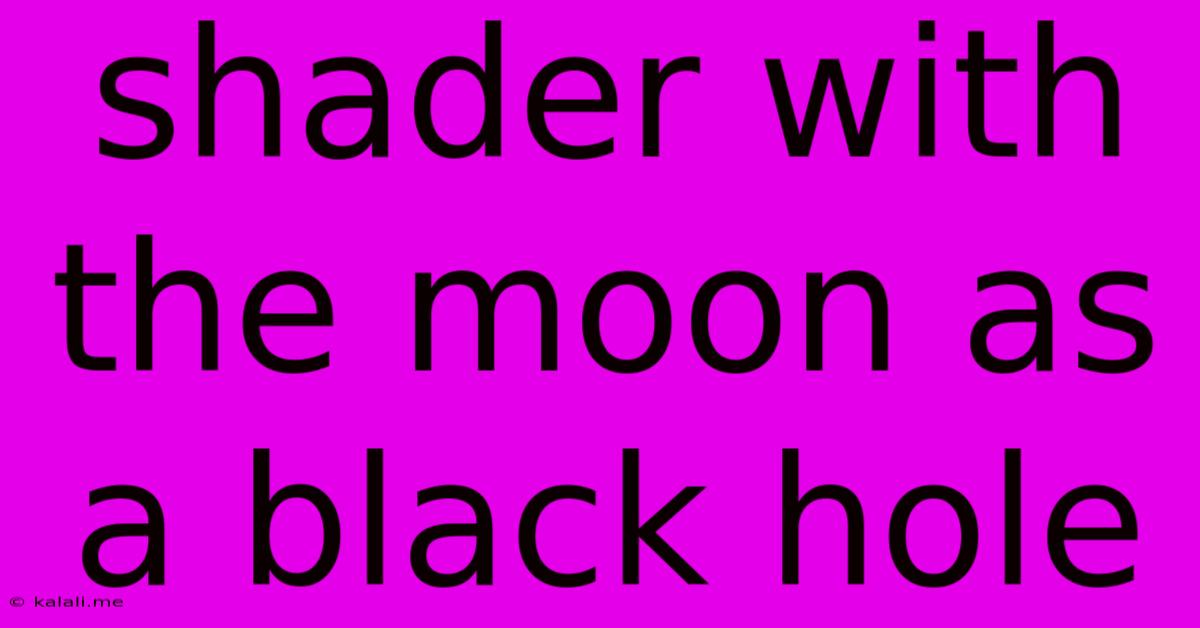Shader With The Moon As A Black Hole
Kalali
Jun 06, 2025 · 3 min read

Table of Contents
Shaders with the Moon as a Black Hole: A Celestial Visual Effect
This article delves into the fascinating world of shaders and explores how to create a captivating visual effect: depicting the moon as a black hole. We'll cover the fundamental concepts, techniques, and considerations involved in achieving this mesmerizing celestial transformation. This effect, achievable through various shader languages like GLSL or HLSL, is a compelling example of how shaders can drastically alter and enhance visual environments in games, simulations, and artistic projects.
Understanding the Fundamentals: Gravitational Lensing and Black Hole Simulation
Before diving into the technical aspects of shader programming, let's grasp the underlying astronomical concepts. A black hole's immense gravity warps spacetime, resulting in a phenomenon known as gravitational lensing. Light bends around the black hole, distorting the appearance of objects behind it. This is the visual effect we aim to replicate in our shader. We'll simulate this distortion by manipulating the texture coordinates of the moon and the surrounding space.
Implementing the Shader: Key Techniques
Creating this effect involves several key steps within your chosen shader language. Let's outline the general approach:
-
Texture Mapping: You'll need a texture of the moon. This will be the base image that we'll warp and distort.
-
Coordinate Transformation: This is the core of the effect. We'll create a function that transforms the texture coordinates based on their distance from the center of the "black hole moon". The further a pixel is from the center, the less it will be distorted. Closer pixels will be significantly warped, creating the lensing effect. This transformation can involve mathematical functions like inverse square laws to mimic the gravitational pull.
-
Color Adjustment: The area immediately surrounding the black hole might need darkening or saturation adjustments to enhance the visual realism. This can be achieved by adjusting the color values based on the distance from the center point.
-
Ambient Occlusion (Optional): Adding ambient occlusion can increase the realism by darkening the areas where the light is blocked by the "black hole moon's" gravitational effects.
Shader Code Example (Conceptual GLSL):
While providing complete, functional shader code within this context is impractical due to length constraints and varying shader environments, here's a conceptual snippet to illustrate the core idea of coordinate transformation:
// ... other shader code ...
vec2 transformCoordinates(vec2 uv, vec2 center, float radius, float strength) {
vec2 diff = uv - center;
float dist = length(diff);
if (dist < radius) {
float warpFactor = strength * (radius - dist) / radius; // Adjust strength as needed
return center + diff * (1.0 + warpFactor);
}
return uv;
}
void mainImage( out vec4 fragColor, in vec2 fragCoord )
{
vec2 uv = fragCoord / iResolution.xy;
vec2 moonCenter = vec2(0.5); // Center of the moon
vec2 transformedUV = transformCoordinates(uv, moonCenter, 0.2, 2.0); // Adjust values as needed
vec4 moonColor = texture(iChannel0, transformedUV); // Sample the moon texture
fragColor = moonColor;
}
// ... other shader code ...
This simplified example shows a function transformCoordinates that warps the texture coordinates based on distance from the center. You'll need to integrate this into a complete shader, considering aspects like screen resolution, texture sampling, and lighting.
Advanced Techniques and Considerations
-
Ray Tracing: For a more physically accurate simulation, ray tracing techniques can be employed to simulate light bending more precisely around the black hole. However, this approach is computationally more expensive.
-
Depth of Field: Adding depth of field blur can further enhance the realism of the effect, making the distorted areas appear more distant.
-
Multiple Light Sources: Simulating light from various sources and how they are distorted by the black hole will add a more complex and believable visual.
Conclusion
Creating a shader that depicts the moon as a black hole is a challenging yet rewarding project. By understanding the underlying astronomical concepts and employing the techniques outlined above, you can achieve a visually stunning and scientifically inspired effect. Remember that experimentation and iterative refinement are key to achieving the desired aesthetic. This effect offers a great opportunity to learn more about shader programming and visual effects.
Latest Posts
Latest Posts
-
Reduce The Frequency Range Of My Mic
Jun 06, 2025
-
Vocal Mixing Cross Fade Recommneded Length And Curve
Jun 06, 2025
-
How To Make Bike Go Backwards Instead Of Just Forwards
Jun 06, 2025
-
How To Find Heart Crystals Easily In Terraria Potion
Jun 06, 2025
-
Can You Tie Neutrals Together From Different Circuits
Jun 06, 2025
Related Post
Thank you for visiting our website which covers about Shader With The Moon As A Black Hole . We hope the information provided has been useful to you. Feel free to contact us if you have any questions or need further assistance. See you next time and don't miss to bookmark.